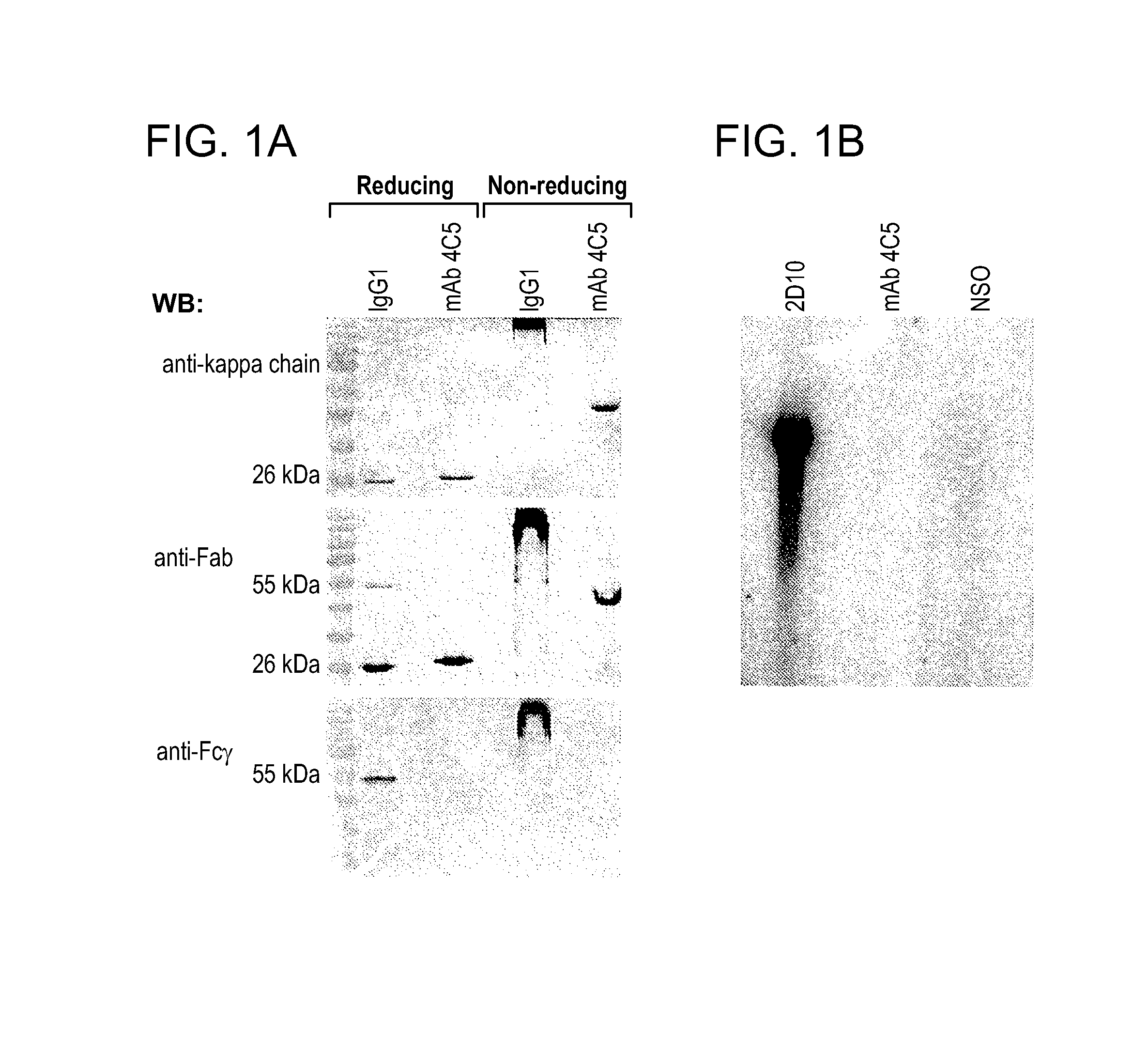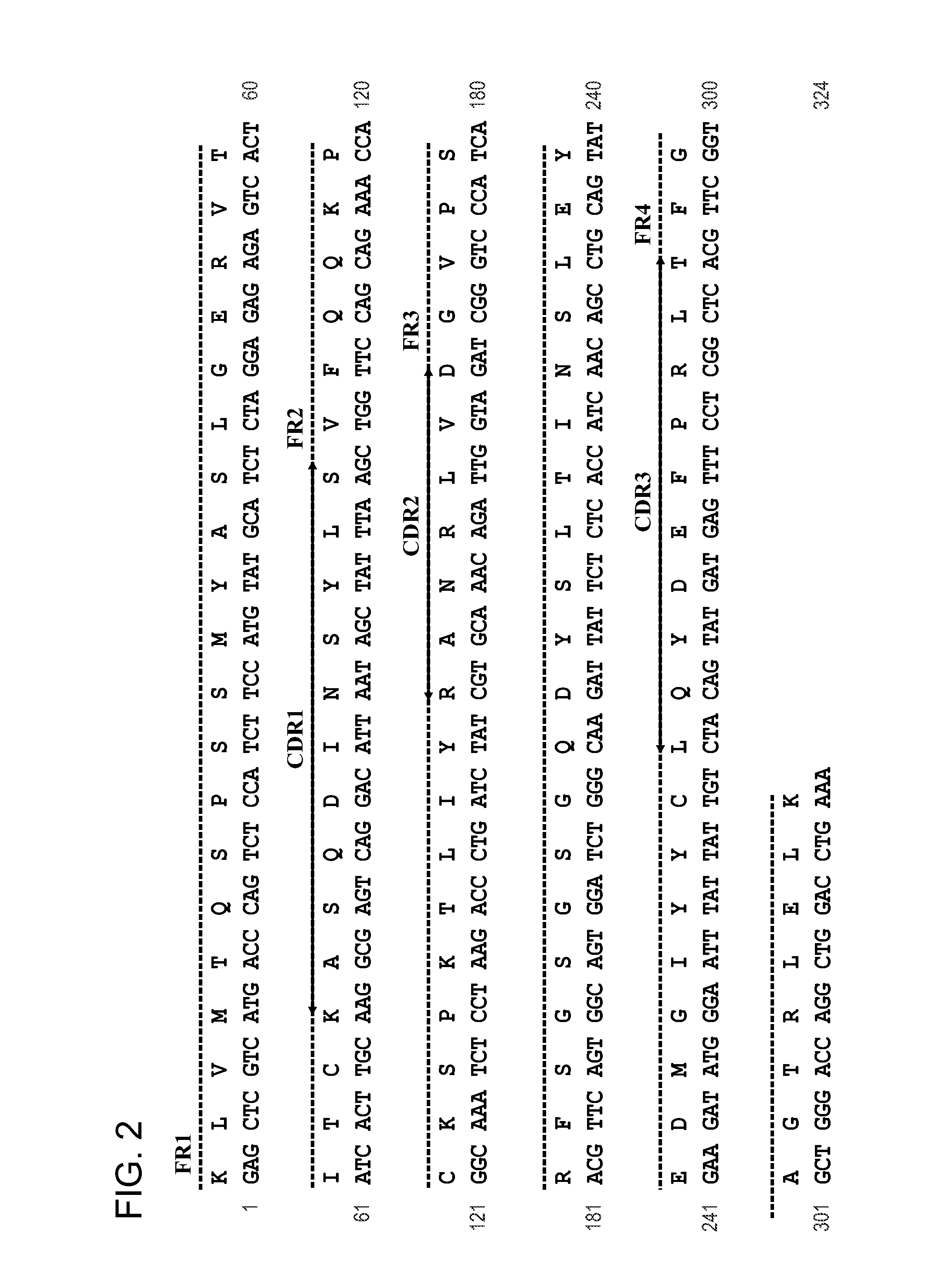Compositions and methods for treating neoplasia
a neoplastic cell and composition technology, applied in the field of compositions and methods for treating neoplastic cells, can solve the problems of reduced cancer cell motility and invasion, murine mabs do not constitute ideal therapeutic agents, and impaired downstream signalling, so as to reduce the growth and/or invasiveness of a neoplastic cell and reduce the growth and/or invasiveness of the neoplastic cell.
- Summary
- Abstract
- Description
- Claims
- Application Information
AI Technical Summary
Benefits of technology
Problems solved by technology
Method used
Image
Examples
example 1
MAb 4C5 Lacks a Heavy Chain
[0129]The electrophoretic motility of mAb 4C5, which was isolated from hybridoma cultures, was studied under reducing and non-reducing SDS-PAGE. This analysis revealed that this murine monoclonal antibody is not a conventional IgG molecule. When purified mAb 4C5 was subjected to reducing SDS-PAGE, followed by immunoblotting with an anti-mouse Fab antibody, the typical 25 kDa and 50 kDa bands, corresponding to the antibody light (L-) and heavy (H-) chains respectively, of a conventional IgG antibody were not observed. Instead a single band of approximately 25 kDa was seen (FIG. 1A). Interestingly, an identical 25 kDa single band was obtained after immunoblotting with an anti-kappa L-chain antibody (FIG. 1A). Accordingly, after non-reducing electrophoresis followed by immunoblotting with both the above mentioned antibodies, mAb 4C5 was shown to be significantly smaller than a conventional IgG1 molecule since it migrated at approximately 50 kDa instead of 150...
example 2
A Human-mouse Chimeric Antibody was Constructed
[0131]The cDNA encoding mAb 4C5 was isolated from 4C5 expressing hybridomas. The initial amplification of the mAb 4C5 kappa chain gene from the first strand cDNA template was performed using universal mouse L-chain primers. The approximately 650 by PCR product corresponding to the full length mAb 4C5 L-chain, was then subcloned into the SacI and Xbal restriction sites of the pComb3HSS[PC7] vector. The sequence analysis of cloned mAb 4C5 L-chain revealed that it belongs to the kappa chain subgroup I (FIG. 2).
[0132]A human-mouse chimeric 4C5 antibody was constructed by replacing the mouse mAb 4C5 CK with the corresponding human CK domain. The sequence analysis of several recombinant clones confirmed the successful construction of the chimeric mouse-human 4C5. Both recombinant 4C5 and chimeric 4C5 antibodies were expressed in soluble forms in bacterial supernatants and purified. The electrophoretic motilities of the purified antibodies wer...
example 3
Chimeric 4C5 Specifically Recognized HSP90
[0135]In order to explore the specificity of the recombinant L-chains, western blot analysis was performed in MDAMB453 breast cancer cell lysates using a commercially available polyclonal anti-HSP90αantibody (obtained from Chemicon), mAb 4C5, recombinant 4C5, and chimeric 4C5. In all cases a single identical immunoreactive band was observed (FIG. 4A), confirming that the mouse recombinant L-chain and the chimeric human-mouse L-chain retain the specificity of the paternal mAb 4C5. This was further confirmed by immunoprecipitation experiments performed in pre-cleared MDAMB453 cell lysates using polyclonal anti-HSP90 a followed by immunoblotting with mAb 4C5, recombinant 4C5, and chimeric 4C5. In all cases, a single immunoreactive band was observed, indicating that the chimeric light chain specifically recognized HSP90 (FIG. 4B). The same result was obtained when immunoprecipitation was performed using mAb 4C5, recombinant 4C5, and chimeric 4C5...
PUM
| Property | Measurement | Unit |
|---|---|---|
| molecular weight | aaaaa | aaaaa |
| temperatures | aaaaa | aaaaa |
| temperatures | aaaaa | aaaaa |
Abstract
Description
Claims
Application Information
 Login to View More
Login to View More - R&D
- Intellectual Property
- Life Sciences
- Materials
- Tech Scout
- Unparalleled Data Quality
- Higher Quality Content
- 60% Fewer Hallucinations
Browse by: Latest US Patents, China's latest patents, Technical Efficacy Thesaurus, Application Domain, Technology Topic, Popular Technical Reports.
© 2025 PatSnap. All rights reserved.Legal|Privacy policy|Modern Slavery Act Transparency Statement|Sitemap|About US| Contact US: help@patsnap.com



